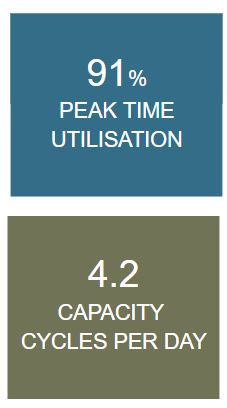3 Key Performance Indicators you should use for Click and Collect
Let’s assume that you have just decided to have a Click and Collect grocery locker solution for your customers. It’s of course an important step for you, your customers and your staff. But to measure how well this is working for you, what key performance indicators (KPIs) should you use? And how will they help to manage your business better?
Usage Frequency
The first indicator looks at the customers. How they like it, how convenient it is, etc. The objective ought to be that customers like it and more importantly use it regularly. The frequency of usage may of course depend on the customers and the products. A desirable development can be seen in the chart below, taken from an actual sample store.
You would ideally like to see that the customer frequency categories are increasing to a reasonable level. If they are not, customer interviews and surveys might help you to understand the reasons behind this and how to address them.
To calculate this KPI, we are using unique customer identifiers. These can certainly be anonymous as the aim is not to collect individual shopping habits. Additionally, use a unique order identifier and the week of collection. In order to conduct further analyses as well, it is good to also track date and time of the respective grocery collection.
Utilisation
Having selected a particular configuration of locker boxes and modules, you would like to see how much of the capacity is actually utilised. This KPI is similar to the cabin fill factor for airliners, where you would like to fill most of the seats and not fly with a half-empty plane.
 Let’s assume that you are using time slots for selecting the collection. An important KPI in this case would be the locker box utilisation during peak times. Optimal is of course a high utilisation, while at the same time making sure there is room to grow further, and offer pick-up to additional customers.
Let’s assume that you are using time slots for selecting the collection. An important KPI in this case would be the locker box utilisation during peak times. Optimal is of course a high utilisation, while at the same time making sure there is room to grow further, and offer pick-up to additional customers.
Another valuable KPI is the number of capacity cycles per day. This means, how many times is each box used on average per day.
To calculate this, divide the number of times groceries were picked up from any box within one day, by the number of boxes that are overall available in your locker solution.
If the utilisation is low, check if you can increase the customer frequency. If the number of capacity cycles is low, then it’s time to attract more customers to locker collection and possibly to analyse the usage by time slot. For some stores the maximum number of cycles will be determined by distribution and loading.
There are of course many other KPIs that can be used, but these are some basic ones to use from the start. After a while of using the system, I do suggest that you should also calculate and use the cost per order as an important KPI.
You can find out more about Click and Collect lockers in this Whitepaper.